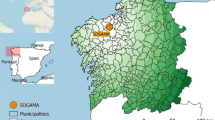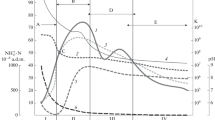Abstract
In the Venice Lagoon (Italy), about 106 t (wet weight) of Ulva rigida biomass are produced annually as one of the major results of eutrophication. Harvests have been initiated to reduce negative impacts of this biomass, however, due to the high costs of such effort, only 40 000 t yr-1 are currently being collected. At the moment, biotransformation into compost seems to be the only feasible technology for utilising large quantities of Ulva biomass. We describe and discuss here a successful composting strategy together with the chemico-physical and microbiological characteristics of the resultant composts. Our composting experiments were conducted at a scale of 20 t. The composting technology utilises large proportions (70–90%) of Ulva biomass and results in a valuable, high-quality end product (compost and compost-based products). This process and the resulting products represents a relatively simple way of utilising the Ulva biomass produced annually in the Venice Lagoon.
Similar content being viewed by others
References
Bardos R, Lopez Real JM (1989) The composting process and susceptible feed stocks, temperature, microbiology, sanitation and decomposition. Bidlingmaier and L'Hermite, Compost Processes in Waste Management.
Bernestein AG (1991) Controllo del degrado ambientale della Laguna di Venezia e raccolta selettiva delle macroalghe. In Sogesta ENI (ed.), Proceedings of the Congress ‘Protezione Ecologica in Adriatico’, Urbino, Italy, 21–22 February 1991: 169–203.
Blunden G, Gordon SM, Mason TG, Turner CH (1986) The characterisation and quantitative estimation of betaines in commercial seaweed extracts. Bot. mar. 29: 155–160.
Brault D, Brian X, Golven P (1985) ‘Les Marees Vertes’ Premier bilan concemant le assais de valorisation. In IFREMER (ed.), Bases Biologiques de l'quaculture. Montepellier, France, 12–16 December 1983. Actes de Colloques 1: 33–42.
Brault D, Golven P, Briand X (1983) Compostage d'algues vertes. Etude experimentale. In: Les vegetaux aquatiques. Biomasse Actualités 12 (Suppl. 3): 31–34.
Briand X, Morand P (1987) Ulva strended algae: away of depollution through methanisation. In Grazi G, Delmon B, Molle IF, Zibetta H (eds), Biomass for Energy and Industry, 4th EEC conference, Elsevier Appl. Sci. Publ., London: 834–839.
Cuomo V, Lombardi C, Perretti A and Palomba I (1991) Possibilità biotecnologiche per il contenimento della eutrofizzazione: Ipotesi e realtà. In Sogesta ENI (ed.), Proceedings of the Congress ‘Protezione Ecologica dell'Adriatico’. Urbino, Italy, 21–22 February 1991: 15–23.
Cuomo V, Merrill J, Palomba I, Perretti A (1993) Systematic collections of Ulva and mariculture of Porphyra: a biotechnology against eutrophication in the Venice Lagoon. J. envir. Studies 43: 141–149.
Finstein MS, Cirello J, Mc Gregor ST, Miller FC, Psarionos KM 1980 Sludge composting and utilisation: rational approach to process control. Final report to WEPA, Dept. Environmental Protection, USA.
Finstein MS, Miller FC, Strom PF (1987) Analysis of EPA guidance on composting sludge. Part I: biological heat generation and temperature. Biocycle 28: 20–27.
Finstein MS, Wei-Rui Lim K, Fischler GE (1982) Sludge composting and utilisation: review of the literature on temperature inactivation of pathogens. NJAES Rutgers, State University, New Jersey, USA.
Fredericksen OF (1987) The fight against eutrophication on the inlet of Odense Fjord by reaping of sea lettuce, Ulva lactuca. Wat. Sci. Technol. 19: 81–87.
IRSA-CNR (1985) Metodi analitici per i fanghi. Quaderno 64. IRSA-CNR, Roma.
Lopez Real JM (1991) Seaweed composting in the United Kingdom. Proceeding of WG 2 Subgroup 3 of COST-48, Venice, Italy, 7–8 June 1991.
Mazé J, Morand P, Potoky P (1993) Stabilisation of ‘Green tides’ by a method of composting with a view to pollution limitation. J. appl. Phycol 5: 183–190.
Missoni G, Mazzagardi M (1985) Production of algal biomass in Venice Lagoon environmental and energetic aspects. In Palz W, Coombs J, Hall DO (eds) Energy from biomass, 3rd EC Conference, Venice, Italy 25–29 March 1985, Elsevier Appl. Sci. Publ. London: 384–386.
Morand P, Carpentier B, Charlier RH, Mazé J, Orlandini M, Plunkett BA, de Waart J (1991) Bioconversion of seaweed. In Guiry MD, Blunden G (eds), Seaweed Resources in Europe Uses and Potential, John Wiley & Sons, Chichester: 95–148.
Morand P, Charlier RH, Mazé J (1990) European bioconversion projects and realisation for macroalgal biomass. Saint Cast Le Guildo (France) experiment. Hydrobiologia 204/205 (Dev. Hydrobiol. 58): 301–308.
Morand P, Cruzado A, Cuomo V, Velasques Z (1992) Macroalgae to help pollution abatement. Proceedings Workshop ‘ollution planning of the Mediterranean Sea’, San Miniato, Italy, 21–24 October 1992.
Orlandini M (1988) Harvesting of algae in polluted Lagoons of Venice and Orbetello and their effective an potential utilisation. In de Waart J, Newhuis PH (eds), Aquatic Primary Biomass (Marine Macroalgae): Biomass Conversion, Removal and Use of Nutrient. Proceedings 2nd Workshop COST 48 Sub-Group 3, Zeist Aut Yerseke, The Netherlands, 25–27 October 1988: 20–23.
Potoky P (1983) Compostage d'algues mélangée La mechanisation des algues: un pilote en vraie grandeur. In Les vegetaux aquatiques. Biomasse Actualités 12 (Suppl. 3): 35.
Potoky P (1988) Seaweed for making fertilising substances in France. In Morand P, Schultze EH (eds), Aquatic Primary Biomass (Marine Macroalgae): Biomass Conversion, Removal and Use of Nutrient. Proceedings 1st Workshop COST 48 SubGroup 3, L'Houmeau, France, 12–14 February 1987, E.E.C., Brussels: 17–18.
Potoky P, Mazé J (1988) Effects of seaweed inclusion in compost preparation on the quality of the compost obtained. In Morand P, Schultze EH (eds), Aquatic Primary Biomass (Marine Macroalgae): Biomass Conversion, Removal and Use of Nutrients. Proceedings 1st Workshop COST 48 Sub-Group 3, L'Houmeau, France, 12–14 February 1987. E.E.C., Brussels: 67–68.
Raninger B (1992) The qualification and certification of compost. ISWA Conference ‘Incineration and Biological Waste Treatment’. Amsterdam Sept 1992.
Stephenson WA (1974) Seaweed in agriculture and horticulture. Bargyla & Glyver, Rateaver, Palm Valley, California, 241 pp.
Vallini G, Pera A, Cecchi F, Valdrighi M, Sicurani MA (1993) Compost stabilisation of algal biomass drawn in eutrophic lagoon ecosystems. Compost Science (Land Utilisation) 1 (2): 49–53.
Zucconi F, Forte MV, Monaco A, de Bertoldi M (1981) Biological evaluation of compost maturity. Biocycle 22 (4): 27–29.
Author information
Authors and Affiliations
Rights and permissions
About this article
Cite this article
Cuomo, V., Perretti, A., Palomba, I. et al. Utilisation of Ulva rigida biomass in the Venice Lagoon (Italy): biotransformation in compost. J Appl Phycol 7, 479–485 (1995). https://doi.org/10.1007/BF00003932
Received:
Revised:
Accepted:
Issue Date:
DOI: https://doi.org/10.1007/BF00003932




